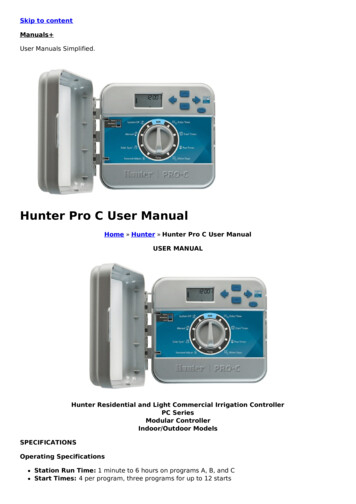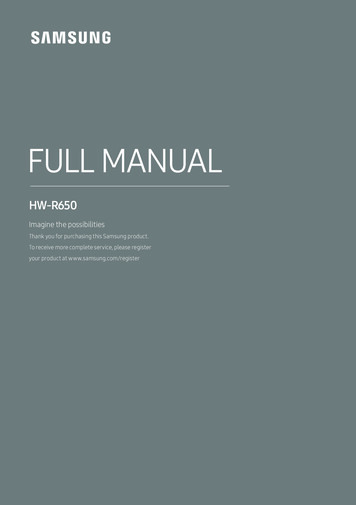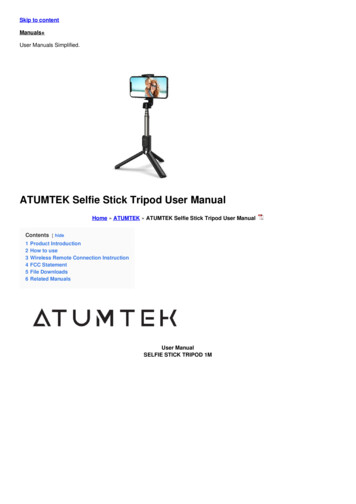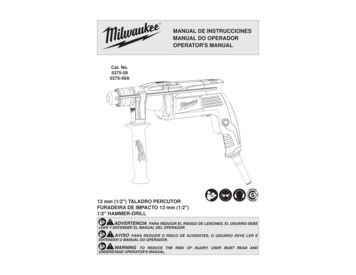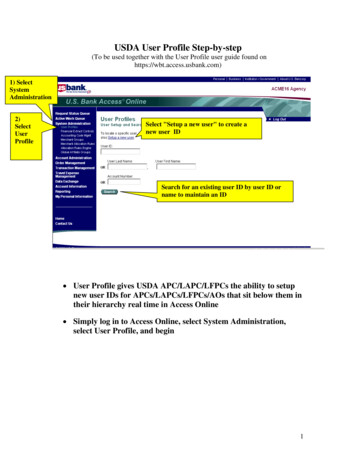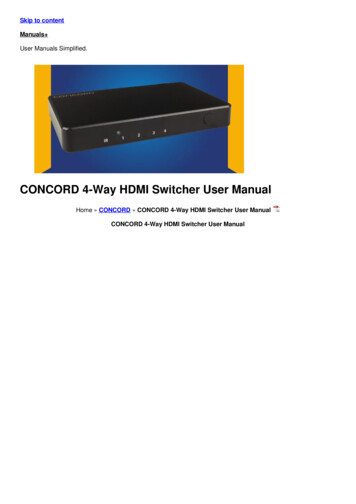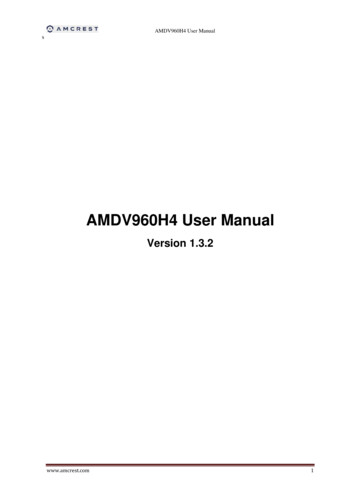
Transcription
AMDV960H4 User ManualsAMDV960H4 User ManualVersion 1.3.2www.amcrest.com1
AMDV960H4 User ManualTABLE OF CONTENTS1PRODUCTION1.1. Product Key Features41.2. Front Panel Controls51.3. USB Mouse61.4. Soft Keyboard71.5. Rear Panel Diagram72GETTING STARTED3LIVE VIEW456749103.1. Understanding Live Preview Icons103.2. Understanding Live Preview Toolbar103.3. Understanding Home Menu113.4. Using Digital Zoom113.5. PTZ Control123.5.1 PTZ Presets, Patrols & Patterns123.5.2 PTZ Context Menu12DISPLAY SETTINGS154.1. Camera Settings154.2. Displays Output Settings16RECORD SETTINGS175.1. Initializing Record Settings175.2. Scheduling a Recording18PLAYBACK AND BACKUP206.1. Playback files from a video search206.2. Understanding the Playback Interface216.3. Backup the recorded file22NETWORK SETTINGS248.1 Configuring General Settings248.2 Configuring Advanced Settings258.2.1 DDNS268.2.2 NTP268.2.3 E-mail Settings268.2.4 FTP Settings27www.amcrest.com2
AMDV960H4 User Manual8.2.4 IP Filter9ALARM SETTINGS28299.1 Motion Detection299.2 Detecting Video Loss309.3 Detecting Exception3110DEVICE MANAGEMENT3210.1 Managing HDDs3210.2 Configuring PTZ Settings3311SYSTEM SETTINGS3411.1 General3411.2 User3511.2.1 Adding a New User3511.3 System Information3711.4 Maintenance3812APP FOR PHONE AND TABLET4012.1 Configure the Amcrest Link4012.2 Live view in Amcrest Link4112.3 Playback in Amcrest Link4213SMARTCLIENT/WEB FOR PC4413.1 Login Your Device4413.2 Live View4513.3 Playback4613.3.1 Remote playback and download4613.3.2 Playback Control4713.3 Local Settings4713.4 Device Settings48www.amcrest.com3
AMDV960H4 User Manual1 PRODUCTIONThank you for your purchase of our Amcrest DVR. To get the most out of your device(s), pleaseread through this User Manual thoroughly. This user manual covers all the models of our DVR.1.1. Product Key FeaturesCompression Analog channels support PAL/NTSC video input, and the recording resolution supports upto 960H Digital channels support 1M, 1.3M, 2M pixels IP camera. Some models support up to 3Mpixel IP camera. Video encoding parameters of each channel can be set separately, including frame rate andbit rate. Supports both composite stream and video only stream. Audio and video streams are strictlysimultaneous.Monitoring Supports VGA and HDMI video output. The display resolution supports up to 1080P. Supports 1/4/8/9/16 screen live view. Supports digital zoom on live view. Supports privacy mask. Supports PTZ preset and patrol.HDD Management Supports 1 8 internal SATA HDD(s) up to 3TB capacity. Supports 1 2 external eSATA HDD(s) up to 3TB capacity. Supports S.M.A.R.T. technology. Use pre-allocating hard disk management technology and no disk fragments.Recording and Playback Supports cycle and non-cycle recording modes. Supports manual, continuous, and motion recording. Supports 8 recording time periods with separate recording types.www.amcrest.com4
AMDV960H4 User Manual Supports Pre-record and Post-record. Supports video data search and playback by channel number, recording type, time, andevent, Supports pause, rewind, play fast, play slow, skip forward, and skip backward when inplayback, located in the progress bar.Backup Supports USB device and network remote backup.Alarm and Exception Supports various alarm inputs such as hard disk full, network break, IP conflict, and harddisk error. Supports various alarm responses such as camera recording, on screen warning, audiblewarning, send email, etc.Network Supports 10/100 adaptive network interface. Supports TCP/IP protocols, PPPoE, DHCP, DNS, DDNS, NTP, UPnP, ONVIF, RTSP etc. Supports remote search, playback, and download video files. Supports remote configuration. Supports remote image capturing. Supports remote PTZ control.Others Supports front panel, mouse, IR control operation. Supports multi-level user management; each user can have individual DVR access rights. Powerful DVR log, including operation, alarm, information, and exception log.1.2. Front Panel Controlswww.amcrest.com5
AMDV960H4 User ManualThe controls on the front panel include:1. USB Ports: Universal Serial Bus (USB) ports for additional devices such as a USB mouseand USB Hard Disk Drive (HDD).2. POWER: POWER indicator lights on when DVR is powered on.3. HDD: HDD indicator lights up when the hard drive is active and, flashes rapidly whenrecording.4. IR Receiver: Receiver for IR remote.5. Function button:a)Play / pause button is used for playback controlb)ALL button is used to live-view all the channelsc)Menu button is used to pop-up the main menud)Select button is used to confirm selection in any of the menu modes6. Direction button: DIRECTION buttons are used to navigate between different fields anditems in menus. In Preview mode, these buttons can be used to cycle through channels.1.3. USB MouseA regular 3-button (Left/Right/Scroll-wheel) USB mouse can also be used with this DVR. Thebuttons on the mouse correspond to:1.Left Button: Single-Click: Select a component of a menu, such as a button or an input field. Double-Click: Switch between single screen and multi-screen mode in Preview/Playback mode. Click and Drag: Clicking and dragging the Left mouse button can be used to control thedigital zoom area. It can also be used to change the live view channel sequence orsetup the alarm areas.2.Right Button: 3.Single-Click: Shows pop-up menu or exit current UI page.Scroll-wheel: This is used to change the selected item for list control.www.amcrest.com6
AMDV960H4 User Manual1.4. Soft KeyboardWhen a mouse is used to perform task on the DVR, clicking on a text input field will bring up theSoft Keyboard.The buttons on the soft keyboard represents:Lowercase: Designates lowercase input is being used.Uppercase: Designates uppercase input is being used.Backspace: Delete the character in front of the cursor.Space: Input spaces between letters.Enter: Confirm selection.ESC: Exit out of Soft Keyboard.1.5. Rear Panel DiagramNoItemDescription1AUDIO INRCA connectors for analog audio input.2VIDEO INBNC connector for analog video input.3AUDIO OUTRCA connectors for analog audio output.4VGADB9 connector for VGA output. Display local video output and menu.5eSATAeSATA port, connect eSATA HDD for recording or backup6HDMIHDMI output, Display local video/Audio output and menu.7LANConnector for LAN (Local Area Network).8USBConnector for USB device.9PTZPTZ control port (Some models don’t support this feature)- RS485.www.amcrest.com7
AMDV960H4 User Manual10DC POWER INwww.amcrest.com12V DC power input.8
AMDV960H4 User Manual2 GETTING STARTED2.1 Starting and Shutting Down Your DVRProper startup and shutdown procedures are crucial to extending the life of your DVR. To startupyour DVR, please plug the power supply into an electrical outlet. It is HIGHLY recommended thatan Uninterruptible Power Supply (UPS) be used in conjunction with the unit. The Power indicatorLED on the front panel should turn on, indicating the unit is receiving power.To shutdown the DVR:1.Enter the Shutdown menu, click on Menu Shutdown.2.Select the Shutdown button.3.Click the OK button.4.Unplug the power supply on the rear panel to safely shutting down the system.2.2Rebooting and Locking Your DVRIn the Shutdown menu, you may also reboot or lock your DVR. Locking your DVR will return youto the Live Preview mode. The username and password must be re-entered to access the menusagain. The Reboot button will reboot your DVR. To reboot or lock your DVR:1.Enter the Shutdown menu by clicking Menu Shutdown.2.Select the Lock button to lock the DVR or the Reboot button to reboot the DVR.www.amcrest.com9
AMDV960H4 User Manual3 LIVE VIEWThe Live Preview mode is automatically started after the DVR boots up. It is also at the very topof the menu hierarchy, thus hitting the ESC multiple times (depending on which menu you’re on)will bring you to the Live Preview mode.3.1. Understanding Live Preview IconsThere are multiple icons on each display in Live Preview mode to indicate different camerastatus. These icons include:Motion Detection Icon: Indicates motion detection.IP Channel Icon: Indicates this is an IP channel. It could be 720P, 960P, 1080P.Record Icon: Indicates the current channel is recording.Audio Icon: Indicates the current channel is outputting audio.Video Disable Icon: Indicate the preview of this channel is disabled.3.2. Understanding Live Preview ToolbarClick any channel in live view mode and a toolbar will be pop up:1. Playback: click this icon to enter the playback menu;2. Audio: mute/unmute this channel;3. PTZ: control the PTZ of this channelwww.amcrest.com10
AMDV960H4 User Manual4. Digital Zoom5. Image parameter control: change the parameters of this camera6. Channel configuration7. Exit toolbar3.3. Understanding Home MenuClick the right-button of the mouse and the home menu will be pop up:1. Home Icon: enter the main menu;2. Single channel live view;3. Four channels live view;4. Eight channels live view;5. Nine channels live view;6. Next group live view;7. Picture in picture mode;8. Manual record;9. Setup wizard;3.4. Using Digital ZoomTo use digital Zoom in Live Preview mode:1. Click one channel on live view, the toolbar will be pop up;2. Select Digital Zoom, enter digital zoom mode:: To enlarge the picture 2 times for each click. 6 times at most;: To shrink the enlarged picture until normal size;: To enlarge the selected area to full screen;: To turn the picture into normal size;: Exit.www.amcrest.com11
AMDV960H4 User Manual3.5. PTZ ControlClicking the PTZ icon on the live-view toolbar will bring up the PTZ control panel.3.5.1 PTZ Presets, Patrols & PatternsThe controls on the PTZ panel include:1.Directional Pad/Auto-scan Buttons: Controls the movements and directions of the PTZ.Center button is also used to start auto-scan of PTZ.2.Speed: Adjusts the movement speed of the PTZ.3.Zoom: Used to zoom in and out with the PTZ.4.Focus: Used to adjust the focus of the PTZ.5.Iris: Used to open up or close the iris of the camera.6.Preset: A Preset is a position that the camera is in which is saved to memory to be retrievedlater. Choose this button to enter preset configuration menu.7.Patrol: Initiates patrol mode. You’ll need to define a series of Preset points for the camera topatrol between. Choose this button to enter patrol configuration menu.8.Exit: Closes the PTZ controls.3.5.2 PTZ Context Menuwww.amcrest.com12
AMDV960H4 User Manual1.Camera No: Switch quickly between cameras.2.Call Preset: Returns the camera to a Preset point.3.Call Patrol: Initiates a patrol of your choice.4.Preset: Defines a Preset point.5.Patrol: Initiates or stops a patrol.6.PTZ Menu: Toggles the appearance of the PTZ Control Menu onscreen. While the PTZControl Menu is hidden, the DVR will still be in PTZ mode. The context menu can still beopened via right-clicking the interface.7.PTZ Settings: Opens the PTZ Settings menu where you can adjust the control method forthe camera.www.amcrest.com13
AMDV960H4 User Manual4 DISPLAY SETTINGS4.1. Camera SettingsCamera menu is where you can make adjustments to how the DVR displays the feed comingfrom your cameras. You can adjust aspects of each channel/camera, including: Camera No.: Choose the camera / channel you want to edit here. The Camera No. is thesame as the number written on the rear panel next to the BNC socket used to connect thecamera.Camera Name: Select a name for the camera you’ve selected. By default, all channels arenamed the same as the Camera No. field, but this can be set to anything you’d like up to 16characters.Disable Preview: When checked, the live view of the channel you’ve selected will bedisabled.Display Camera Name: When checked, the name you’ve selected for the camera/channelwill be displayed on-screen as an overlay.Record Date: When checked, the date (as displayed) will be recorded directly on yourvideos. This can be useful, as it creates an inseparable record of exactly when the footagewas captured.OSD Display Position: Gives you access to a screen where you can easily set the exactpositions of any overlayed text, such as the camera name and the date and time. You cansimply select any item you want to move (such as the Channel Name and/or the Date andTime) and click and drag it to the position you’d like it to be. To exit the OSD Display Positionscreen, press the right click button. A context menu will appear with two options: Save andExit. To exit without saving, simply choose Exit. If you want to save your changes, choosewww.amcrest.com14
AMDV960H4 User ManualSave first. Image Settings: Gives you access to change camera image, including brightness, contrast,saturation, and hueMask: When checked, this allows you to create, place, and shape a “privacy mask” whichobscures part of the image on the associated channel.4.2. Displays Output SettingsLive Preview allows you to customize your display to your own needs.The settings available in this menu include: Display resolution Transparency: To adjust the menu transparency. Mouse Sensitivity Border Adjustment: To adjust the border of video output. Audio: Enables/disable audio output for the selected video output.www.amcrest.com15
AMDV960H4 User Manual5 RECORD SETTINGSThere are multiple ways to setup your DVR for recording. They include setting up a recordingschedule, triggering recording by motion detection, and manually starting the recording.5.1. Initializing Record SettingsBefore setting your DVR up for recording, certain settings should be configured first. The steps toconfiguring these settings are:1.You should initialize the HDD through HDD management before proceeding.2.Navigate to Main Menu Recording. You will be taken to the Recording Settings menu.3.Select the camera you would to configure the settings for.4.Configure settings for: Encoding Parameters: Select main stream or sub stream. Record Audio: Select to record the audio of the camera. Resolution. Frame Rate: Select recordings frame rate. BitRate Type: Select either Variable or Invariable bit rate.www.amcrest.com16
AMDV960H4 User ManualSet additional recording settings: Overwrite: Set to overwrite the HDD to continue recording when it is full. Pre-record: Set to pre-record before the actual recording begins. Post-record: Sets the time to post-record after the actual recording ended. Pack Duration: Sets the time for how long the DVR will be recording before splitting theoutput file.5.2. Scheduling a RecordingScheduling a recording allows you to setup the DVR to only record when you want it to.To setup a recording schedule:1.Enter the Record Settings menu (Main Menu Recording Schedule).www.amcrest.com17
AMDV960H4 User Manual2.Select the Camera to edit schedule for.3.Check Enable Schedule.4.Select recording Type. Recording type can be based on time and triggered by a schedule,motion detection, motion or alarm, and alarm. Motion detected and alarm triggeredrecordings are further explained in Configuring Alarms.5.Repeat the steps for other cameras or copy settings from one channel to others by Copy To.6.Click OK to finish and save the schedule settings.www.amcrest.com18
AMDV960H4 User Manual6 PLAYBACK AND BACKUP6.1. Playback files from a video searchTo initiate playback:1.Select the channel you’d like to playback.2.From the Video Type menu, select the type of video you’d like to playback. The options areManual, Schedule, Motion, and All.3.Set your Start Date/Time and your End Date/Time. If you want to see a graphicalrepresentation of when recordings were made and what recording mode triggered them,www.amcrest.com20
AMDV960H4 User Manualchoose Details.4.Select Search.5.Choose which file you want to play back from the file list;6.Choose which camera you’d like to view the video from.7.To initiate playback, select Play.6.2. Understanding the Playback InterfaceAudio on/off: Select to open or close the audio;Fast backwards: Select to rewind recording files at the speed of x2, x4, x8, x16;Play: Select to return to normal speed to playback files;Pause / Single Frame: Select to pause or play in single frame;Fast Forwards: Select to play the recording files forward at the speed of x2, x4, x8, x16;Slow Forwards: Select to play the recording files forward at the speed of x1/2, 1/4,1/8,1/16;Hide: Select to hide the play control panel;Exit: Select to exit playback;Zoom out the timeZoom in the timewww.amcrest.com21
AMDV960H4 User ManualPop Up menu: Supports digital zoom, show/hide the console and exitplayback.6.3. Backup the recorded fileTo backup the recorded files:1.Select the channel you’d like to backup.2.From the Video Type menu, select the type of video you’d like to playback. The options areManual, Schedule, Motion and All.3.Set your Start Date/Time and your End Date/Time4.Select Backup and the backup file list will be shown.www.amcrest.com22
AMDV960H4 User Manual5.Select the file(s) to be backup, and click Next;6.Click Refresh to look for USB devices to which recorded files can be backed up;7. Click Start to begin the backup.www.amcrest.com23
AMDV960H4 User Manual7 NETWORK SETTINGS7.1. Configuring General Settings1.Network Access: Here you can choose between the three different types of networks thatthe DVR can be connected to. The three types of networks are:1) DHCP: DHCP (Dynamic Host Configuration Protocol) is a system where one device onyour network (usually a router) will automatically assign IP addresses to devicesconnected to the network.2) STATIC: Static networks require all devices to have their IP addresses manually defined,as there is no device dedicated to automatically assigning addresses.3) PPPoE: An advanced protocol that allows the DVR to be more directly connected via aDSL modem. This is an option for advanced users only.2.If you select Static in Network Access, you will need to input the IP Address, Subnet Mask,Default Gateway, and DNS information.www.amcrest.com24
AMDV960H4 User Manual7.2. Configuring Advanced Settings1.DDNS: The place to configure the DVR to automatically update a dynamic DNS service. Ifyou want to remotely access the DVR via the Internet, you’ll probably need to configure aDDNS account.2.NTP: Network Time Protocol. If you’ve got the DVR connected to the Internet, you can haveit automatically sync time with an online server.3.Email Settings: Where you can configure the DVR to work with an email account of yourchoice. This must be correctly configured for the DVR’s auto-email feature to work.4.FTP Settings: The DVR supports uploading live-view streaming or recording file to a FTPserver. Here you can configure the FTP server information and the schedule for uploading.5.IP Filter: An advanced feature which allows you to exercise precise control over whatdevices/IP address(es) are allowed to communicate with the DVR and which are not.Recommended for advanced users only.6.Server Port: This is the port that the DVR will use to send information through. When youaccess your DVR from web browser or client software, you need to input the server port.7.HTTP Port: This is the port through which you will be able to log in to the DVR via webbrowser.8.RTSP Port: This is the port through which you will be able to live-view the DVR via RTSPclient software.9.UPNP: UPnP makes configuring your network easier and faster. To use the UPnP setting onthe DVR, you’ll need a router which supports this feature, with UPnP enabled.10. UID: The DVR’s Unique Identifier code for P2P. For convenience, you can have this codesent to your email account by clicking the Send UID button (provided that you’ve already setup your email account).www.amcrest.com25
AMDV960H4 User Manual7.2.1. DDNSTo setup DDNS:1.Check the DDNS checkbox to enable feature.2.Select DDNS Type.3.Input the user name and password7.2.2. NTPA Network Time Protocol (NTP) Server may also be setup on your DVR to keep the date andtime current and accurate.1. Auto Sync: Enable auto-sync, your DVR will automatically sync up the time with the NTPserver.2. Synchronize Every: When you enable Auto Sync, here you can define the time in minutesof how often the synchronization should be.3. NTP Server and NTP Port: NTP server IP address and port.7.2.3. E-mail SettingsTo configure E-mail settings:www.amcrest.com26
AMDV960H4 User Manual4. Enter e-mail settings.5. Click the Test button to test e-mail settings.6. Select Attached Picture if you want to send email with alarm images, the interval of twoadjacent pictures is configurable.7.2.4 FTP SettingsFTP is used to upload streams to your FTP server. You can set up an uploading schedule whichis triggered by time, motion detection, or/and alarm.To configure FTP settings:www.amcrest.com27
AMDV960H4 User Manual7. Configure FTP server settings.8. Configure the uploading schedule.There are multiple icons in Live Preview mode to indicate FTP uploading status when FTPuploading is triggered. These icons include:This icon indicates the DVR is uploading the stream of this channel, and it work very well.This icon indicates the DVR is trying to upload the stream of this channel, but it failed. Youshould check FTP server configuration, network, and server.7.2.5 IP FilterIP filter is used to manage the remote access to your DVR. The management is based on the IPaddress of remote visitor.1.White List: If you select the white list, only the listed IP addresses can connect your DVR.While2.Black List: If you select black list, the listed IP addresses cannot connect your DVR.3.None: If you want to disable this function, please select NONE for restricted type. Then anyIP can have access to the DVR.www.amcrest.com28
AMDV960H4 User Manual8 ALARM SETTINGS8.1. Motion DetectionSet up properly, using motion detected recording will increase the number of days your DVR isable to record. It will only record relevant events rather than recording everything, makingsearching for an event easier. To set up motion detection:1.Select the channel you’d like to configure.2.Check the checkbox of Enable to enable Motion Detection.3.Click the applicable Set button of Motion Detection to setup the motion detection area andsensitivity for that channel.4.Configure the schedule for motion detection. User can define when it’s armed or disarmedduring 24x7.www.amcrest.com29
AMDV960H4 User Manual5.Configure the Action can define what will happen when the camera detects motion. Theactions include turn on the buzzer, send email, and trigger recording.8.2. Detecting Video LossVideo Loss is regarded as a potential alarm event, and is considered to occur any time that theDVR doesn’t receive an active video signal on any of its inputs. The default behavior of the DVR,when a channel has no incoming video signal, is simply to display “Video Loss” on a blackbackground over the associated channel. If you’re not using all the inputs on your DVR, thensome channels will be in a“permanent” Video Loss state. Just be sure that you don’t enable avideo loss action for these channels.1.Channel: Which channel/camera you’d like to set the Video Loss behavior for.2.Enable: Whether the selected channel has video loss monitoring active or not.3.Schedule: Alters when the current Video Loss Action will be active.4.Action: The action you’d like the DVR to take when this event occurs. It’s set in the sameway as the Action for any other event.www.amcrest.com30
AMDV960H4 User Manual8.2.3. Detecting ExceptionSetting exceptions allows the DVR to alert you when irregular events occur. These events include:1.HDD Full: All installed HDDs are full.2.HDD Error: Errors occurred during writing of the HDD, no HDD installed, or HDD had failedto initialize.3.Net Disconnected: Disconnected network cable.4.IP Conflict: Conflict in IP address settings.www.amcrest.com31
AMDV960H4 User Manual9 DEVICE MANAGEMENT9.1. Managing HDDsA newly installed hard disk drive (HDD) must be first initialize before it can be used with yourDVR. Initializing the HDD will erase all data on it.To initialize a HDD:1.Select HDD to initialize.2.Click the Init button.3.Select OK button to begin initialization. After the HDD has been initialized, the status of theHDD will change from No to Yes.www.amcrest.com32
AMDV960H4 User ManualTo view SMART information of a HDD:1.Select one HDD.2.You can see the detail S.M.A.R.T information of the HDD.9.2. Configuring PTZ SettingsSettings for a PTZ camera must be configured before it can be used. Before proceeding, verifythat the PTZ and RS-485 of the DVR are connected properly.To configure PTZ settings:1.Select channel where PTZ camera is installed next to the Camera label.2.Enter PTZ settings according to the camera.3.Click OK button to save and exit menu.www.amcrest.com33
AMDV960H4 User Manual10 SYSTEM SETTINGS10.1. GeneralGeneral menu contains many of the settings you’ll need to configure to get the most out of yourDVR system:1.Language: You can select the language you want for the menus/GUI.2.Video Standard: Here you can choose between PAL and NTSC.3.Time Zone: Particularly important if you’ve enabled NTP - set this to the time zone whereyou happen to be.4.Menu Date Format: The format of the date (eg. DD/MM/YYYY or MM/DD/YYYY and so on).5.System Time: This can be edited manually, or set to update automatically by using NTP6.DST Setting: As the standards for daylight savings differ from country to country, and oftenstate to state, you might need to manually tell the DVR exactly when it commences andends in your locality. First, turn DST on. We suggest setting the Daylight Saving Time Modeto Date, and manually entering the dates and times that daylight savings time applies to andfrom, in your locality.7.Device Mode: DVR supports several modes, including 4CH analog mode, 4Ch analog 4Ch IP mode. Changing the mode will reboot the system.8.Enable Password: When enabled, the DVR will require a password to access, even forlocal users. It’s advisable to enable password protection9.Auto Lock Time: When the password protection is enabled, the DVR will automaticallytime-out, thereafter it will ask for a password before returning to normal functioning. Thewww.amcrest.com34
AMDV960H4 User ManualAuto Lock Time determines how long a period of inactivity will cause the DVR to lock itselfagain.10. Device Name: Differentiates your DVR from other devices. If you don’t have any otherDVR’s or similar devices, then you can leave this as-is. If you’ve got multiple DVRs runningon the same network, then it’s a great idea to give each a unique name.10.2. UserBy default, your DVR comes with one user account, the Administrator account. TheAdministrator user name is admin and the password is 12345. The default password forAdministrator should be changed right away for security reasons. The Administrator has theauthority to add, delete, and configure parameters for many of the system functions. To add additional users, choose Add. To remove a user, choose Delete. To customize a user’s level of access, choose Modify. You cannot modify the access levelof the default admin account - they can do everything. This is to prevent an unfortunateincident where, for example, no user has the permissions required to change another user’spermissions - which could lead to the DVR being, in at least some senses, inoperable.10.2.1. Adding a New UserYou may add up to 10 new users to your DVR.To add new users, select Add:www.amcrest.com35
AMDV960H4 User Manual1. Enter information for new user, including User Name, Password and Level.2. The Level is the user level and is separated into two tiers. Operator: The Operator user level has the authority to configure two-way audio innetwork settings and all parameters in channel settings. Guest: The Guest user can not configure network settings, but can configure the localplayback as well as the remote playing in channel settings.3. Select the Permission button to enter the Permission Settings menu.4. Configure privileges for local settings under the Configuration tab. The configuration pagespecifies which menu(s) the user can access. There is no hierarchy and any combinationof menus can be selected (although some combinations would make little sense inpractice).5. Configure privileges for operation under the Operation tab. You can select which channelsthe user has access to and what they can do with them. For example, you could set a userto have permission to view all channels in live viewing mode, but only playback channels 2and 4.www.amcrest.com36
AMDV960H4 User Manual10.3. System InformationSystem information is for use by technical support. When you call for technical support, you needto provide the information here.www.amcrest.com37
AMDV960H4 User Manual10.4. MaintenanceEnable auto reboot: Will automatically shut the DVR down and restart it at a certain time of theday or week. To ensure your DVR work stably, it’s recommended to enable this checkbox.Auto reboot at: Choose when you’d like the DVR to reboot. Typically, this will be a time when it’sunlikely there’ll be any activity for the DVR to record.Firmware Upgrade (Upgrade): Instructs the DVR to update its firmware. You’ll only need to usethis option if instructed to do so by Technical Support. (Remember to Export your configurationfirst so you don’t have to re-set everything!)Default Settings (Restore): Loads the factory default settings. This must be done after afirmware upgrade to ensure proper operation of the DVR. You can retain your settings, recordingschedule and so on by using the Import/Export Configuration function before upgrading thefirmware.Configuration (Export): Creates a file containing all the settings you’ve customized, includingyour recording preferences, schedule, user-list and so on.To export your settings:www.amcrest.com38
AMDV960H4 User Manual1. Insert a USB flash drive into the USB port on the front of the DVR. Ensure it has enough freespace (a few MB is sufficient - the file is less than 50KB) and that it is not write-protected.2. Choose Configuration:
www.amcrest.com 3 8.2.4 IP Filter 28 9 ALARM SETTINGS 29 9.1 Motion Detection 29 9.2 Detecting Video Loss 30 9.3 Detecting Exception 31 10 DEVICE MANAGEMENT 32 10.1 Managing HDDs 32 10.2 Configuring PTZ Settings 33 11 SYSTEM SETTINGS 34 11.1 General 34 11.2 User 35 11.2.1 Adding a New User 35 11.3 System Information 37

